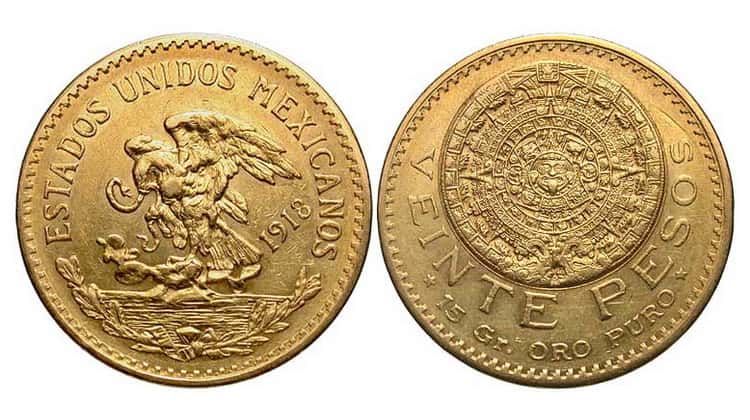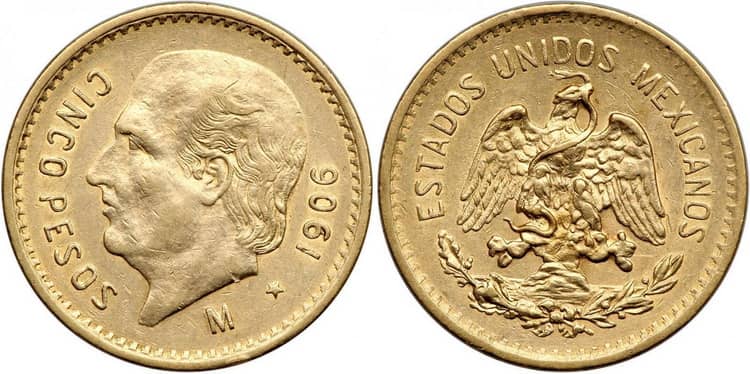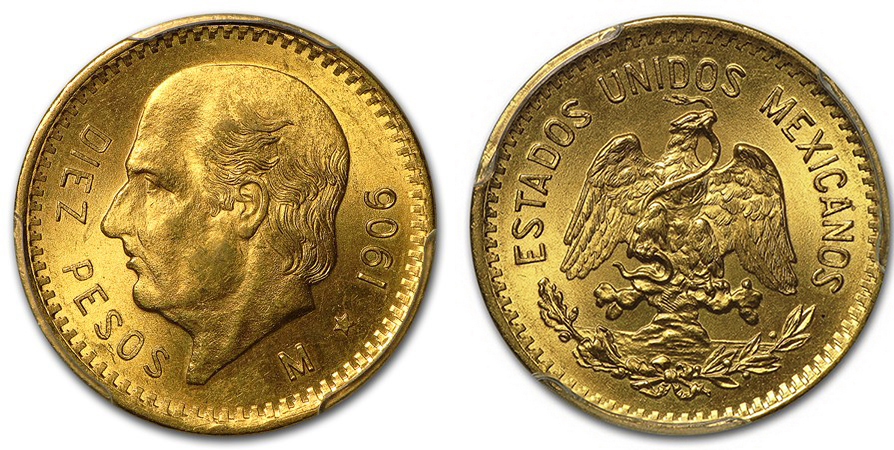
Coins of 5 Mexican pesos (of 1905-1920, without the 1955 edition), 10 Mexican pesos (of 1905-1920, without the 1959 edition), 20 Mexican pesos (of 1917-1921, without the 1959 edition) started to be minted in the XX century, when Mexico adopted the gold standard under the Monetary Reform Act of 1905. The coinage was centralized, and the use of Mexican trading coins was discontinued. During this monetary reform, the gold content in pesos was reduced by 49.36%, and bronze coins of 1 and 2 centavo, nickel 5 centavos, silver 10, 20 and 50 centavos and gold 5 and 10 pesos were issued. In 1931, Mexico abandoned the gold standard of its currency, the exchange of banknotes for gold was stopped. The gold coins were withdrawn from circulation. Since 1935, silver pesos have also come out of circulation, and Bank of Mexico banknotes have become the legal currency.
Types of coins
5 Mexican pesos (of 1905-1920, without the 1955 edition)
- Gold content: 0.1206 oz.
- Sample: 900.
- Weight: 4.166 g.
- Diameter: 19 mm.
- Edge thickness: 1.14 mm.

10 Mexican Pesos (of 1905–1920 without the 1959 edition)
- Gold content: 0.2411 oz.
- Sample: 900.
- Weight: 8.33 g.
- Diameter: 22.5 mm.
- Edge thickness: 1.40 mm.

20 Mexican pesos (1917–1921, without the 1959 edition)
- Gold content: 0.4823 oz.
- Sample: 900.
- Weight: 16.67 g.
- Diameter: 27.5 mm.
- Edge thickness: 2.03 mm.

Mexican Peso Circulation
Gold Mexican pesos minted at the beginning of the XXth century were produced mainly in fairly large amount, for example coins of 5 pesos.
|
Year of issue |
Circulation (pcs.) |
|
1905 |
18 000 |
|
1906 |
4 638 000 |
|
1907 |
1 088 000 |
|
1910 |
100 000 |
|
1918 |
609 000 |
|
1919 |
509 000 |
|
1920 |
2 385 000 |
Design development
Gold coins of 5 and 10 pesos denomination, which were minted in the period from 1905 to 1920, have exactly the same design and differ only in indicating the denomination, size and weight.
- Obverse: In the center of the coin there is the side-face of Mexican revolutionary hero Miguel Hidalgo y Costilla. To the left there is the indication of “CINCO / DIEZ PESOS” denomination, and to the right there is the mark of the Mint (Mexico City) together with the year of issue. The edge of the coin is decorated with a jagged ornament.
- Reverse: The national emblem of Mexico is depicted in the center of the coin. It is an eagle holding a snake in its beak. The eagle itself stands on a huge cactus, which is surrounded on all sides by water. The head of the eagle is directed upwards, and there is the inscription “ESTADOS UNIDOS MEXICANOS” (“United States of Mexico”) engraved above it. At the very bottom of the coin there are the crossed branches of oak and laurel, tied with a ribbon. The edge of the coin is decorated with a jagged ornament.
- Edge: smooth.
Gold coins of 20 pesos denomination, which were issued between 1917 and 1921, significantly differ in design. The experts consider them the most difficult among coins in the world.
- Obverse: At the top of the coin, the Aztec Solar Calendar is engraved. On the bottom edge of the Calendar there are the denomination “VEINTE PESOS” (“Twenty Pesos”) and the inscription “* 15 Gr. ORO PURO *. The edge of the coin is decorated with a jagged ornament.
- Reverse: The national emblem of Mexico is depicted in the center of the coin. It is an eagle holding a snake in its beak. The eagle itself stands on a huge cactus, which is surrounded on all sides by water. The head of the eagle is directed downwards, and there is the inscription “ESTADOS UNIDOS MEXICANOS” engraved above it. The year of issue is indicated to the right of the inscription. At the very bottom of the coin there are the crossed branches of oak and laurel, tied with a ribbon. The edge of the coin is decorated with a jagged ornament.
- Edge: smooth with the inscription “INDEPENDENCIA Y LIBERTAD” (“Independence and Freedom”).
It is no coincidence that on all these coins an eagle with a snake is depicted. The legend of the founding of Mexico City says: “After the Aztecs see an eagle sitting on a cactus with a snake, this place, in accordance with their prediction, should be the place for the founding of their city of Tenochtitlan (now Mexico City)”.
What Mint produces the coins?
The Mint of Mexico City was founded by the Vice-King of Antonio de Mendoza in 1535. It is the oldest Mint in the Western Hemisphere. One of the backgrounds for the Mint’s founding was the Spanish conquest of Aztec city of Tenochtitlan was led by Hernan Cortes in 1521. Today this city is known as Mexico City. The wealth of this land, which at that time was called “New Spain”, lay in huge deposits of gold and silver. The Spaniards quickly realized that coins are the most efficient way to transport found wealth back to Spain. As a result, the historic Mint in Mexico City was founded. Spanish coins, such as silver or copper 8 reals, were the first coins produced by this Mint.
The official mintage of gold coins in the Mexican Mint did not start until the beginning of the reign of Habsburg King Charles II (1679). It was these gold coins that were the predecessors of Mexican gold coins (commemorative and any other). Subsequently, the Mint of Mexico City began to produce silver coins. The most attractive for coin collectors and investors are Mexican silver commemorative coins, since they are more affordable.
Cost of coins on the market
The gold Mexican pesos of 1905-1921 attract numismatists collectors all over the world due to their beauty, the high purity of gold and the historical value. Naturally, their cost will be much higher than the nominal, so on the exchanges and online auctions, prices can vary within the following limits:
- 5 pesos of 1905-1920 − 185,54-193,27 $ USD
- 10 pesos of 1905-1920 − 314.95-328.05 $ USD
- 20 pesos of 1917-1921 − 620,03-646,01 $ USD
Interesting Facts
- Often you can come across another name of ancient golden Mexican pesos (1959 & PRIOR) (mainly 5 and 10 pesos denomination) − “hidalgo”. The reason for this was the use of the portrait of Miguel Hidalgo y Costilla (1753-1811) on their obverse. He was a professor of theology, as well as a Mexican freedom fighter who began an armed struggle for freedom against the Spanish occupying forces. On September 16, 1824, Miguel Hidalgo called Mexican citizens to action, and this day was declared a national day after the foundation of the Mexican Republic.
- Since 1982 the Mexican national emblem with an eagle and a snake has also been used on silver and gold Mexican libertad which, on the obverse, depict the Winged Freedom − a symbol of the Independence of Mexico.
- Since 2015, the Mint in Mexico City has minted Mexican large silver libertad, weighing 1, 2 and 5 troy ounces.
- Silver Aztec series of Mexican coins with images of six ancient civilizations was commissioned by the Bank of Mexico in 1992, which coincided with the 500th anniversary of the discovery of North America by Columbus in 1492.
- From 1905 to 1976, the Mexican peso had the status of one of the most stable currencies of Latin America, keeping the rate of 12.5 Mexican pesos for 1 $ USD, operating under the Bretton Woods Agreement.
Comments
No commens yet.